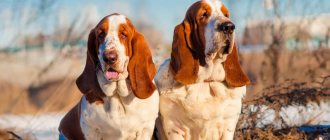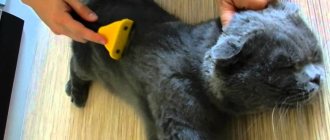History of the breed
Labrador Retrievers are native to the island of Newfoundland, located off the northeastern Atlantic coast of Canada. Labrador Retrievers originally served as companions and helpers to local fishermen beginning in the 1700s.
The dogs worked side by side with their owners all day long, catching fish, hauling nets, transporting logs, and then returning home with their owner.
Although their origins are unknown, many believe that the St. John's dog was crossed with the Newfoundland and other native water dogs.
The British brought several Labrador Retrievers to their country, which were used for hunting. The Earl of Malmesbury was the first person to name dogs Labradors.
Surprisingly, Labradors were nearly extinct by the 1880s, and the Malmesbury family and other English admirers are credited with saving the breed. In Newfoundland, this breed became extinct due to government restrictions and tax laws. Families were allowed to keep no more than one dog, and owning a female was heavily taxed, so female puppies were selected from litters.
However, the breed survived in England, and in 1903 the Kennel Club recognized the Labrador Retriever as a special breed. Today, Labrador Retrievers are employed in drug and explosive detection, search and rescue, therapy, assisting the disabled, and as hunters. They also excel in all types of canine competitions.
Minuses
Needs a lot of exercise, attention and training
Heavy shedding
Prone to overeating and gaining excess weight
Who are Labrador Retrievers Suitable for?
Although they were bred to be hunting dogs, these qualities also make them excellent companions. In addition to their athletic abilities, Labradors make excellent service dogs.
They are often trained as guide dogs for the blind, assistance dogs for the disabled, and therapy dogs, as well as drug and explosive detection dogs, water rescue dogs, and search and rescue dogs.
Character of Labrador Retriever
- Kind
- Smart
- Prompt
- Responsive
- Confiding
- Balanced
What conditions make up a dog's character? It is widely believed that the character of a four-legged pet is determined at the genetic level. Also, many people close to cynology argue that character traits are nothing more than the consequences of training and daily upbringing of a puppy. The conditions under which the pet is kept also play an important role. You should not expect your pet to be sociable and friendly towards people if he has been shouted at since childhood, waved at with a leash, or with a newspaper.
Experienced dog breeders will certainly say that if you want to achieve mutual understanding with your own pet, then you must match in temperament and in some character traits. To correctly choose the breed that suits you, first study this issue theoretically: consider the exterior of the dogs you like, read the breed standard, pay attention to the description of the temperament and characteristics of the breed's behavior, ask questions to the real owners of the breed you are interested in. If, in theory, you are satisfied with the breed of your future pet, go to a nursery, or to people engaged in private breeding. A competent breeder who cares about his breed will readily respond to your requests for help in selecting a puppy. It is difficult to say with certainty what kind of character your chosen dog will grow up to be in such a short period of time. There are several simple tests with which you can choose a little friend with the qualities you need.
Care and maintenance of an adult Labrador at home
Proper care of your Labrador requires a balanced diet, hygiene, regular brushing and other nuances.
The right diet
A balanced diet is the key to good dog health. In order not to think about creating a diet from natural products that need to be prepared, you can purchase premium dry food - it is already balanced, containing all the necessary substances in the right proportion.
If you have the opportunity and desire to create your pet’s diet yourself, it should include the following products:
Important! It is difficult for amateur dog breeders who do not know how to care for a Labrador to create a complete diet for a puppy, so it is better to consult with the breeder.
Bathing puppies and adult dogs
Those who plan to keep a Labrador in an apartment are most interested in the following questions:
Does a Labrador smell like a dog? This breed secretes a special sebaceous secretion that saturates the undercoat, insulating it. If you watch a dog while bathing, you will notice that at first the water simply rolls off the fur - this is the result of the release of that same secretion. It also gives the dog its characteristic smell.
| How often should you wash your Labrador as a child or adult? | You can only bathe your pet using dog shampoo. Water procedures are carried out as the animal becomes dirty, but not to get rid of the smell. Excessive bathing and improper use of detergents dry out and irritate the skin. |
Important! Even the most careful hygiene of Labradors will still not rid the dog of the characteristic odor, so do not try desperately to “wash” your pet!
Grooming
Labrador grooming is limited to combing and brushing. You can cut your Labrador's hair, but owners usually don't do it. A dog with a haircut can only be found at exhibitions. The Labrador's coat needs to be brushed at least three times a week, and during shedding, which occurs twice a year, brushing is done daily.
You need to comb your pet with a brush or a special mitten. A simple comb will not cope with dense and coarse hair. The dog should be accustomed to this procedure from childhood.
Important! Grooming your Labrador is not a must! The dog has short hair with undercoat, so there is no need to shorten it.
Ear care
The Labrador's ears also require care - once a week it is necessary to inspect the dog's ears. You can clean your pet's ears with a cotton pad dipped in water at room temperature.
If suddenly a puppy’s ears do not lie as they should according to breed standards, or become curled, then in some cases this indicates that the baby is teething.
Important! Most often, ticks and other parasites are located on the dog’s ears.
Nail care
Trimming a Labrador's claws is done if the dog has not sharpened them naturally by running on asphalt or ground. You can trim the claws either independently, leaving 2 millimeters from the living tissue, or in grooming centers or veterinary clinics.
Walking and exercise
You need to walk your Labrador at least twice a day. You need to walk a puppy more often than an adult dog. Walks are combined with training, for example, you can teach a puppy to respond to a name, and also teach it simple commands like “Near!”, “Ugh!” and so on.
During this period, the dog socializes, ceases to be afraid of other people and animals, and learns to respond correctly to extraneous sounds.
Labrador is an active dog, characterized by curiosity and playfulness. This description can be written down as both pros and cons of the breed. On the one hand, a dog will not let you get bored and is perfect for active people.
On the other hand, even if a person loves the breed very much, but is not a fan of long walks, a Labrador with such an owner will not be happy and healthy.
A hunting dog needs daily running, constant play, tug-of-war and jumping. This will not only allow you to burn off energy, but also maintain the tone of your muscles and bones and avoid gaining excess weight.
If possible, it is recommended to take your pet to a pond or river - the dog swims well and loves to do it, and such water procedures have a beneficial effect on the overall tone of the body.
Health and treatment of Labradors
The pet must be observed by a veterinarian and undergo a course of mandatory vaccinations - the age of vaccination and the date of the repeat procedure will be indicated by the doctor.
Labrador, like any other dog breed, loves to pick up and eat things from the ground. Often dogs try to eat a dead bird, eat spoiled food from the trash heap, or do something else dangerous to their health.
Then the risk of poisoning increases, which can be determined by the following symptoms: the pet becomes lethargic, trembling and vomiting, and convulsions appear. In this case, you need to immediately contact a veterinarian!
There are some allergy sufferers among Labradors. The reasons for this can be both food and insects, and sometimes the fur of other animals. Allergenic itching appears, tufts of fur fall out, and redness inside the ears is observed. In this case, the veterinarian will help identify what exactly the pet is reacting to and prescribe appropriate remedies to eliminate the symptoms.
Female Labradors are prone to blocked milk ducts. The general descriptive character of mastitis is inflammation of the mammary glands, fever, and often purulent discharge.
If the manifestation of mastitis is not serious, you can give a light massage, apply something cool to the nipples, or treat them with anti-inflammatory ointment. If your dog's condition worsens, you should seek help from a doctor.
Important! Boys also have mammary glands, but they do not perform the same function as girls. Therefore, boys are also not immune to the development of mastitis, although this is rare.
Labrador Retriever: features of the breed
- Labrador Retrievers love to eat and are prone to obesity. Limit the number of treats and provide more exercise.
- These are large and energetic dogs that need education and training.
- Labrador Retrievers were bred for physically demanding work and have a lot of energy. They need at least 30-60 minutes of exercise per day. Without this, they can throw out their unspent energy with destructive actions, such as barking and gnawing things left behind.
- More than other dogs, Labradors are accustomed to chewing on a variety of objects.
- They usually remain active throughout their lives.
- Excellent swimmers, as they were bred to retrieve game.
- Suitable for living in the city.
How and what to feed a Labrador Retriever
Feed your Labrador 1.25 - 1.5 cups of dry dog food twice a day. Servings vary depending on your dog's size and activity level.
Nutritional needs change throughout a dog's life, and you should discuss this with your veterinarian at each visit. Be sure to provide your Labrador with fresh, clean water.
Labradors often gain weight and become obese because they love to eat and have poor volume control. You need to portion out the food throughout feeding times to prevent your dog from overeating.
If you notice that your dog has gained weight, discuss with your veterinarian how you should change your feeding schedule, type and amount of food, and exercise. Obesity can shorten your dog's lifespan.
Health
Like any other breed of dog, the Labrador Retriever is prone to certain diseases:
- deafness;
- dysplasia of the hip and elbow joints;
- prone to obesity;
- formation of malignant and benign tumors.
Preventive measures to protect your Labrador Retriever puppy
- To keep your Labrador Retriever puppy completely safe, you first need to minimize his contact with unfamiliar dogs, especially strays. Therefore, you should not let your dog off the leash, as in this case it will become impossible to control its behavior and communication with other dogs. Since a dog can easily become infected with distemper from simply touching the nose of a sick animal. This disease can be transmitted to a dog through sniffing. Your dog can become infected with trichophytosis from contact with the lichen-affected fur of a sick dog. Naturally, it is impossible to completely exclude a dog’s communication with other dogs, since it must be socialized. Therefore, try to find friends with dog lovers who look after their animals. By adhering to this rule, you can eliminate the risk of pathogen transmission by 80%.
- You should walk your dog in places where there are no landfills. Since garbage very often attracts rodents, which in turn are very often carriers of various infections. Gray rats are especially dangerous because they carry such a serious disease as leptospirosis.
- You should not allow your dog to sniff other people's feces, as they are a source of worms.
- Monitor your Labrador Retriever's well-being. Pay attention to even the most minor changes in his behavior. For example, your dog may appear lethargic, lose his appetite, or have a dry nose. Or you may notice that the dog begins to shed, and this has nothing to do with seasonal shedding. If hair loss becomes excessive, this is the first symptom indicating health problems in your pet. And only you can help him. Therefore, it is important to take the dog to the veterinary clinic in time, where the disease can be overcome for sure. In no case should you ignore the symptoms, since advanced infections are much more difficult to treat, and sometimes even impossible. If you start treating your dog, the disease can lead to his death or he will develop serious complications that will affect his hearing, vision, limbs and much more.
How to properly care for a Labrador puppy?
It must be taken into account that during the first year of life the pet behaves very actively. He will not lie down all the time, so the owner will have to create safe conditions for the Labrador to live in the apartment.
Along with carpeting, you will need to remove fragile and dangerous objects - the puppy may drop, break or stain something while playing.
Dogs of this breed change by about one and a half to two years. Proper training and education of Labradors will help the owner better control the pet's hyperactivity.
The decision to own a Labrador should be closely related to responsibility and the understanding that at a young age he will require special attention and will be very bored alone.
Training and education
Labradors are incredibly active and highly trainable dogs. During the training process, it is necessary to avoid harsh punishments.
Submitting a dog doesn't always work. The principle of complete submission of the Labrador Retriever to the owner is an outdated method. This theory was formulated based on observations of packs of wild wolves, but they were kept in captivity and, of course, experienced stress. The stress condition forced wolves to show aggression towards each other, but in the wild they do not show aggression to each other - they live together and interact with each other. You need to perceive yourself as the more experienced and mature member of the pack, who is responsible for guiding the new member (Labrador Retriever puppy) and teaching him good behavior, as well as correcting him if necessary. It is important to remember that Labrador Retriever puppies learn a lot on their own. They are very inquisitive, love to explore new territories and, of course, experiment. Puppies tend to repeat actions they enjoy (like playing with a toy). They do not repeat actions that cause them pain (for example, destroying a nest and getting bitten). If your Labrador Retriever puppy misbehaves, ignore him and praise him when he does the right thing. Reward your puppy for following commands and good behavior. Do not neglect these tips. After all, constantly hearing “you can’t” all day long is unbearable. This is a small child who wants to know everything and get his portion of treats as a reward for not eating your favorite rug, going to the toilet outside, bringing you a ball, and so on.
Set rules and monitor their implementation
It is worth enrolling your Labrador Retriever puppy in obedience training classes. These classes will allow you to understand exactly what actions will allow you to control your dog’s behavior. You will be able to spend more time with your puppy, establish contact and socialize around other dogs.
Adviсe
- Training a Labrador Retriever puppy should be done with the help of positive motivation; watch carefully special films about this technique. The Canine Translator film series from National Geographic is suitable.
- If you need to leave your puppy at home alone for 2 hours or more, then ask someone to come to him.
- Be sure to schedule your Labrador Retriever puppy an appointment with the veterinarian as soon as possible. The doctor will carefully examine him and give him vaccinations that will protect him from dangerous diseases.
Which cat should I get if I already have a dog, and vice versa?
Which cat to have in an apartment with a dog: 5 breeds
These purrs will make excellent company for your wet-nosed friend.
- Maine Coon
They are also called “ideal cats for dog lovers.” Not only does the Maine Coon get along well with dogs, he also behaves like a dog: he can fetch toys, imposingly walk with his owner on a leash, and learn commands. And the dimensions of these cats are quite large - just the size of an average dog. And the wet-nosed ones, in turn, recognize the mustachioed giant as one of their own and do not even try to compete with him.
- Siberian
Another big guy among the felines who gets along well with pets. And with dogs - first of all. The Siberian cat will not fight for the right to occupy a leading position; she would rather prefer peace and friendship.
It is worth noting that Siberians will only become bosom friends with their relatives and dogs. This breed cannot be kept in the same house with rodents, rabbits and birds. Or you will have to completely isolate the “hunter” from the “victims” so that they do not catch each other’s eyes.
- Abyssinian
The playfulness of the Abyssinian beauty allows her to become a wonderful friend for an equally active dog. At the same time, this is a balanced and even intelligent barbel, from whom you won’t have to expect any unpleasant surprises.
As in the case of the Maine Coon, Abyssinian cats also exhibit some canine habits: they will willingly fetch thrown objects and learn interesting commands. And there are legends about the devotion and loyalty of the Abyssinians.
- Ragdoll
This soft-bodied, good-natured cat is rightfully considered one of the calmest cat breeds. A Ragdoll will never show aggression or let out its claws. And if a child or a playful dog pesters him, the ragdoll will remain unperturbed. Most likely, this breed does not have conflicts with dogs precisely for this reason: ragdolls are too kind and to some extent lazy, and therefore do not try to teach their annoying neighbor a lesson. It's easier to wait out the onslaught.
- Burma
From childhood, Burmese grow up affectionate, intelligent and with good manners. They have developed empathy, so they will greet even a stranger with curiosity and without any fear. The sociality of the Burmese allows her to become part of any company, even the largest one. And we are talking not only about the company of people, but also animals. The affectionate beauty will find a common language with everyone.
Also, jealousy and a sense of rivalry are completely unknown in Burma. Therefore, a dog that has been caressed by its owner will not get hit in the face by a Burma with a clawed paw.
Don't forget that every pet is an individual. Any cat, even a purebred purr, can become an excellent companion for a dog.
What kind of dog to have in an apartment with a cat: 5 breeds
If you don’t know what kind of dog to get in an apartment with a cat, then pay attention to the breeds listed below. They will not engage in fierce battles with their mustachioed comrades - rather, on the contrary, they will sincerely love them.
- Boxer
This is just a boxer in appearance - a formidable and harsh beast, but inside he is a real sweetheart who wouldn’t hurt a fly. If a boxer is raised correctly, he will not touch not only a cat, but also a bird and a mouse. And these dogs love to play. Therefore, for an energetic cat, a boxer will be a wonderful playmate.
- Newfoundland
Newfies are considered one of the most suitable dogs that can be safely kept in the same home as a cat. The size of the cosmatic is, of course, gigantic, but he knows how to control himself. So you don’t have to be afraid that the big guy, in a fit of play, will send your cat flying with one wave of his paw. But this does not mean that four-legged friends can be left unattended, especially if the purr is still very small. Newfies, unfortunately, do not always see where they are sitting.
- King Charles Spaniel
All English dogs have royal manners, and the King is no exception. An intelligent dog gets along well with other pets and does not try to dominate or zealously attract the attention of its owner. It will be great if the king is accompanied by an equally peaceful and well-mannered cat. They will have a great time, warming each other in warm hugs.
- Retriever
Both the Labrador Retriever and the Golden Retriever are incredibly charming and friendly dogs. They adore people, even strangers, and are ready to lick everyone from head to toe. Their boundless love also extends to cats, which, by the way, is not always pleasant for cats. If an equally loving and sociable cat lives under the same roof with a retriever, then quarrels will certainly be avoided. Ideally, the ponytails will mutually adore each other.
- Chihuahua
A tiny dog understands perfectly well that it is 2 or even 3 times smaller than a cat. Therefore, it simply makes no sense for her to claim a dominant position in the house. Cats do not see Chihuahuas as rivals, so most often they treat them indifferently or condescendingly.
But be careful - an aggressive and pugnacious cat can offend your baby. Therefore, a balanced and quiet cat is suitable as an ideal neighbor for a Chihuahua.
Most conflicts between cats and dogs occur not because they are “from different planets,” but because they have different temperaments. Dogs are usually cheerful, active and obsessive, while cats are independent, willful, and love solitude. If you choose breeds of cat and dog that are similar in character, they will probably not be at odds. But the owner needs to do something else for peace and order in the house. We'll talk about this further.
How to behave as an owner so that the cat and dog get along
The friendship of pets most often depends on the actions of the owner. If he behaves correctly, then even completely different four-legged animals can get along.
Follow these rules:
- Be sure to train your dog, it must obey you unquestioningly. A dog is much easier to control than a cat, especially since most often it is the dog that can cause harm to its mustachioed roommate. You must stop the watchdog's actions in time and do it on command.
- Affection and attention should always be divided equally for your charges. Often a puppy or kitten is brought into the house when there is already another adult pet in the house. Don’t forget about the “old man”, pay him more attention, otherwise he will be offended by the new family member and begin to be jealous.
- Do not give toys from one pet to another, as this will provoke resentment.
- If your pets start to fight, intervene immediately, but do not yell at them or hit them. Separate calmly but confidently.
- Do not feed four-legged animals nearby. This is a lot of stress for each of them, because the presence of another animal nearby while eating awakens a sense of competition. It is better to give food in different rooms. At least for the first time.
- Be sure to praise and give treats to your pets when they treat each other well: they lick each other, lie peacefully together, play kindly. This way you will reinforce positive behavior and the four-legged animals will have no reason to quarrel.
- If a cat is annoyed by an overly active dog, then “wear out” the dog on a walk: let him spend all his energy so as not to bother the cat later. Take care of the purr’s peace of mind: give her a secluded place where she can rest alone from all of you, for example, on a closet or the highest shelf of a cat play set.
- Keep both pets' nails trimmed regularly, even if they don't fight. This can happen at any moment.
- Never encourage physical pressure or hunting of one four-legged animal on another, no matter how funny it may look. Puppies often play with cats' tails and try to bite them a little. Stop this behavior immediately, because the puppy will grow up, but the habits will remain.
A tailed family is not only happiness, but also a great responsibility. If you take into account the breed characteristics of your charges and adhere to the rules, then the cat and dog in your home will become best friends.
The article was written with the support of the Valta Academy of Pet Business.
Expert:
Vashchenko Lyudmila
is a veterinarian, a happy owner of Maine Coons, Sphynx and German Spitz.
Where to buy a Labrador Retriever puppy?
A specialized nursery is the best place to buy a good Labrador Retriever puppy. If pedigree and thoroughbred are important, then it is better to hire an experienced dog breeder to help. If not, then you can trust your heart. On nursery websites, there are customer reviews that will help you navigate. A little secret or life hack: visit a dog show where the desired breed will be presented. Chat with the owners of the breed, ask about the nuances, find out where they purchased the puppies. True dog breeders live for their pets, so they will be happy to answer any question and give valuable advice. Typically, nurseries send their representatives to exhibitions, where there is a chance to meet in person and take a business card.
How to choose a strong and healthy Labrador Retriever puppy
The day has come to go to the nursery for a cute puppy. Babies should be kept in a clean enclosure, without a specific unpleasant odor, which is very important. First of all, the breeder will demonstrate the numerous awards that his pets have received. Listen carefully, but don’t be easily fooled by all the big titles and championship accolades. If possible, you need to look at the parents of the future pet. The main 10 signs that will help you choose a healthy Labrador Retriever puppy:
- shiny and moist nose;
- clean ears, pink;
- lively, clear look;
- clean eyes, without any discharge;
- healthy skin, without parasites, sores and acne;
- silky, shiny coat;
- lymph nodes of normal size;
- tail without creases;
- no bloating.
A good proof that the animal is healthy is a written document of purchase and sale. If a Labrador Retriever puppy develops abnormalities over time, according to the contract, the pet can be returned. Having “insurance” with the buyer will reduce the risk that the seller will slip in a problem animal.
Age for adoption
- Professional Russian dog breeders advise buying 8-10 week old puppies. At this age, the baby should already be vaccinated, toilet trained, and receive basic education.
- An important point: it is not recommended to take a puppy home immediately after separation from its mother. Until 9 weeks of age, the baby learns dog language and learns to communicate with its own kind. He needs to spend several weeks in a doggy daycare.
- A professional breeder knows that a Labrador Retriever puppy less than 6 weeks old should not be given away. A very small puppy can only be given to an experienced owner who knows how to raise it correctly. This option is not suitable for a beginner.
- Depending on the breed, the puppy can be picked up earlier or later than 10 weeks of age. Large dogs grow more slowly, so it is recommended to remove them from kennels at the age of 3 months. Puppies of such breeds should gradually build up bone and muscle tissue, without sudden jumps, in order to avoid problems with the musculoskeletal system.
- For show- or breed-class Labrador Retriever puppies, the age of “adoption” can only be 6-9 months. This is a mandatory condition, because it is at this age that the makings of a champion and the distinctive signs of thoroughbred are revealed. You need to have patience to get a future titled champion.
Note : even the most expensive Labrador Retriever puppy cannot with a 100% guarantee become a champion. The breeder’s job is to assess the potential and make a forecast. Next, you need to raise the puppy and train it for a long time in order to realize the makings of a champion.
Documentation
- The Labrador Retriever puppy has a mark in the groin area or it may be on the ear, as well as a puppy card (metric). The codes on the card and on the stamp must be identical.
- Metrica is the primary document that is issued for a puppy when it reaches the age of 45 days. Next, a qualified dog handler examines the babies and notes any defects found. The owner of the dog, if desired, can change the metric to a new document, pedigree, at the age of 6-15 months. This document will allow the pet to participate in breeding.
- Another document for the puppy is a veterinary passport, with mandatory vaccination and deworming notes.
Interesting facts about Labrador retrievers
- Labrador retrievers' fur repels water.
- The breed is often used by detective services to search for prohibited substances and people.
- Labradors are called differently - St. John's dog or small Newfoundland.
- This breed of dog has webbed paws.
If you decide to get a dog, then get ready for the following: you will often have to clean up little mistakes after your puppy; investments will be required in annual vaccinations, feeding, toys, ammunition, etc.; Any animal requires attention and communication, so if you don’t have time, then there will be no mutual understanding with your Labrador Retriever puppy. Big changes are coming in your life. If you can handle this, you will find a loyal friend for life. Character of a Labrador Retriever: who is better to take a bitch or a dog?
Labrador Retriever The character of a dog depends on heredity and breed characteristics, but proper upbringing and training is also of no small importance. In the article... Read more
Labrador Retriever color
Labrador Retriever Color is a canine term that refers to the color of a dog's coat. It is one of the most important traits in breeding... Read more
Training and education of a Labrador retriever
Labrador Retriever Raising a dog is about developing correct behavior. This is the basis for successful training. Training is a set of activities aimed at… Read more
Labrador Retriever diseases
Labrador Retriever Each dog breed is predisposed to certain diseases. We have collected information about typical diseases of the breed. Remember the symptoms of the disease, the risk... Read more
Labrador Retriever
Grooming a Labrador Retriever
How to care for the coat of a Labrador Retriever?
They have smooth, water-resistant coats and otter-like tails, making them excellent water dogs. The coat is short and does not require special care, as it naturally sheds most of the debris; you do not have to brush the dog after a walk.
However, since Labradors do not shed hair well, regular weekly brushing is needed to distribute the natural oils and remove some old hair.
You'll need a good vacuum cleaner for your home, and be aware that your clothes will contain at least some dog hair.
How long should you bathe a Labrador?
Labradors need a bath approximately every two months.
How much exercise does a Labrador Retriever need?
Your dog gets a lot of exercise, so he may naturally wear out his nails—if you hear a click on a hard floor, be sure to trim his nails. This may need to be done once or twice a month.
How to care for your Labrador's teeth?
Attention to oral hygiene is very important for health and longevity. It's good to brush your dog's teeth daily or at least two to three times a week.
How to care for your Labrador Retriever's ears?
Check the ears weekly for any signs of infection, which is common in dogs whose ears get wet from bathing.
Who are Labrador Retrievers Suitable for?
Labradors do best in homes where they can get plenty of exercise and exercise.
This breed is energetic and does not do well in apartment living, requiring 30-minute walks and visits to dog parks where it can burn off its energy.
If you have a fenced yard, you can play there with your dog.
What to do with a Labrador?
Keep in mind that Labradors can be escape geniuses, so your dog should wear identifying marks on his collar. Bad behavior can occur if the Labrador is left alone most of the day and not sufficiently occupied.
Labradors love to reach for things and love to carry them in their mouth.
Provide them with durable chew toys and mouth balls.
How to train a Labrador?
Train your dog from an early age to be good on leash and obedient. This ensures that you have a good canine citizen and not a noisy, unruly dog.
Socialization will also help your dog learn to be around other people, dogs, and other pets without being afraid or defensive.
Is Labrador Retriever suitable for families and children?
As true family dogs, Labradors usually get along well with children and are incredibly loyal, affectionate and playful.
However, small children should always be supervised until they learn how to behave around a large animal.
If older children behave well with the dog, a Labrador is a good choice for the home.
How does a Labrador get along with a cat?
Labradors get along well with other pets - dogs and cats, especially if they are socialized.











